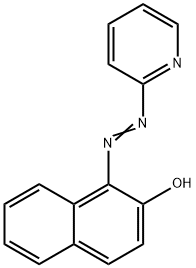
| 1-(2-Pyridylazo)-2-naphthol Basic information |
| Uses |
| Product Name: | 1-(2-Pyridylazo)-2-naphthol |
| Synonyms: | 1-(2-pyridinylazo)-2-naphthaleno;1-(2-Pyridylazo)-2-Hydroxynaphthalene;O-PAN;1-(2-Pyridylazo)-2-n;1-(2-Pyridylazo)-2-naphthol 99%;1-[(E)-2-Pyridinyldiazenyl]-2-naphthol;2-Hydroxy-1-(2-pyridylazo)naphthalene;2-Naphthol, 1-(2-pyridylazo)- |
| CAS: | 85-85-8 |
| MF: | C15H11N3O |
| MW: | 249.27 |
| EINECS: | 201-637-9 |
| Product Categories: | Pyridylazo Compounds;Analytical Chemistry;Azo Compounds;Chelating Reagents;Naphthylazo Compounds;Intermediates |
| Mol File: | 85-85-8.mol |
| 1-(2-Pyridylazo)-2-naphthol Chemical Properties |
| Melting point | 138-141 °C (lit.) |
| Boiling point | 392.37°C (rough estimate) |
| density | 1.1469 (rough estimate) |
| refractive index | 1.5700 (estimate) |
| storage temp. | Store at +5°C to +30°C. |
| pka | 8.86±0.50(Predicted) |
| form | Powder/Solid |
| color | green to red, upon chelation with metal |
| Water Solubility | Insoluble |
| BRN | 206390 |
| Stability: | Stable. Incompatible with strong oxidizing agents, strong bases. |
| CAS DataBase Reference | 85-85-8(CAS DataBase Reference) |
| NIST Chemistry Reference | 2-Naphthalenol, 1-(2-pyridinylazo)-(85-85-8) |
| EPA Substance Registry System | 2-Naphthalenol, 1-(2-pyridinylazo)- (85-85-8) |
| Safety Information |
| Hazard Codes | Xi |
| Risk Statements | 36/37/38 |
| Safety Statements | 26-36-37/39 |
| WGK Germany | 3 |
| TSCA | Yes |
| HS Code | 29333999 |
| MSDS Information |
| Provider | Language |
|---|---|
| 1-(2-Pyridylazo)-2-naphthol | English |
| SigmaAldrich | English |
| ACROS | English |
| ALFA | English |
| 1-(2-Pyridylazo)-2-naphthol Usage And Synthesis |
| Uses | 1-(2-Pyridylazo)-2-naphthol is an indicator of transition metals. 1-(2-Pyridylazo)-2-naphthol is an indicator in complexometry and a reagent for the extraction and spectrophotometric determination of many transition metals. Dyes and metabolites. |
| Chemical Properties | orange crystals |
| Uses | 1-(2-Pyridylazo)-2-naphthol is an indicator of transition metals. 1-(2-Pyridylazo)-2-naphthol is an indicator in complexometry and a reagent for the extraction and spectrophotometric determination of many transition metals. Dyes and metabolites. |
| General Description | 1-(2-Pyridylazo)-2-naphthol (PAN), an orange colored dye, is commonly used as an acid-base indicator. It can form chelates with metal ions, which makes it a valuable indicator in complexometric titrations. PAN is also a spectrophotometric reagent, which can extract metal chelates into an organic solvent. |
| Agricultural Uses | 1-(2-Pyridylazo)-2-naphthol is a hard stratum of strongly compacted soil caused by continual plowing to the same depth of hardened soil which has high clay content. The precipitated iron and silicates cement the soil particles and form pans. 1-(2-Pyridylazo)-2-naphthol often impede drainage and root growth. It can be broken up using a subsoiler . |
| Purification Methods | Purify PAN by repeated crystallisation from EtOH or MeOH. It can also be purified by sublimation under vacuum. Purity can be checked by TLC using a mixed solvent (pet ether/Et2O/EtOH; 10:10:1) on a silica gel plate. It has pK1 1.9 and pK2 12.2 in 20% aqueous ethoxyethanol. It chelates with copper [Pease & Williams Anal Chem 31 1046 1959]. [Beilstein 22 I 694, 22 III/IV 7073, 22/4 V 618.] |
| 1-(2-Pyridylazo)-2-naphthol Preparation Products And Raw materials |
| Raw materials | CARBON DIOXIDE-->Sodium cyanide-->Cyclohexane-->2-Aminopyridine-->Ethyl nitrite-->3-(2,2-Dichlorovinyl)-2,2-dimethylcyclopropanecarbonyl chloride |
| Preparation Products | CARAMEL-->polyaniline composite film |
Please leave a message for us or use the following ways to contact us, we will reply to you as soon as possible, and provide you with the most sincere service, thank you.